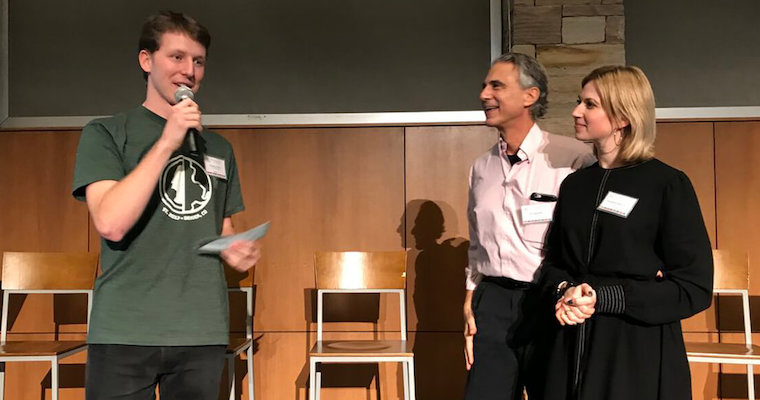The Family Business: Matching Older and Younger Entrepreneurs

This article is part of America’s Entrepreneurs, a Next Avenue initiative made possible by the Richard M. Schulze Family Foundation and EIX, the Entrepreneur and Innovation Exchange.
When a midlife entrepreneur launches a business with his or her adult child or with a twentysomething or thirtysomething co-founder, it’s often a winning recipe. These intergenerational pairings are frequently energizing and, based on what I learned writing my forthcoming book with Next Avenue, Never Too Old to Get Rich: The Entrepreneur’s Guide to Starting a Business Mid-Life, represent a great blueprint for success.
So I was delighted to learn about what Jim Sugarman (a boomer) and his daughter, Samantha (a millennial), are doing to play matchmaker for prospective intergenerational partnerships with their nonprofit enterprise, 4GenNow, and to connect them with potential funders.
The Advantages of Older/Younger Co-Founder Teams
Here’s what I love about this kind of startup synergy: The older partner can bring decades of experience, potential clients or customers and possibly capital while the younger one can deliver the ambition of someone in the early stages of a career, plus an eagerness to try new ways of doing things. Frequently, the younger partner is especially tech savvy, too.
OneClick.chat is a perfect example of this kind of partnership, according to Jim Sugarman. Co-founders of the web-based video chat startup, Dillon Myers and Alan Gibson, graduated from Washington and Lee University — in 2014 and 1970, respectively.
The Sugarmans launched their intergenerational matching and advising service in 2016, and it has steadily gained traction in building a roster of interested entrepreneurs across all ages. The 4GenNow LinkedIn community now has 900 Gen Z, millennial, Gen X and boomer entrepreneurs in 35 states and 23 countries. Last year, it held a Summit and Angel Accelerator events in Denver.
How the 4GenNow Process Works
They hope to start pairing several teams of older and younger entrepreneurs later this year, using the database they’ve amassed of prospects.
There are 10 steps in the 4GenNow process. Things kick off with a free online survey and a one-hour complimentary phone session to review an individual’s passion, personal characteristics and what he or she is looking for in a partner. That’s followed by creating a match, help preparing a video and pitch deck and finally, orchestrating a virtual pitch to an angel investor with the goal of securing funding. The Sugarmans charge an upfront fee of $495. If an intergenerational match isn’t made in six months, they provide a full refund.
Jim Sugarman, a serial entrepreneur himself, has hopscotched from failures to success. But his one big achievement was a business he co-founded with a decades-younger partner. Hence, the impetus for the entrepreneurial match-making service.
But he was also spurred on by an examination of the state of entrepreneurship in America these days. “The truth is that while the number of business startups has risen in recent years, it is far below pre-Great Recession levels,” he says. “There are too few startups — and far too many fail — most within five years.”
Compelled to help solve that problem, Sugarman reached out to Samantha, then studying for a business degree from Northeastern University. He asked for her input on the concept of intergenerational partnerships.
“She embraced the idea and wanted to work with me to develop it. Our goal is not just to create more startups, but to set them up to succeed over the long run,” he says.
Prime Qualities of Each Generation
Each generation brings its own special sauce to a partnership, according to Sugarman, who credits Amy Lynch of Generational Edge for parsing out some of the qualities different generations typically embody:
Boomers (born between 1946 and 1964), he says, tend to be workaholics and get the job done. “We have that drive and passion,” Sugarman says.
Gen X ers (born between 1965 and 1976) are often pragmatic and efficient, focused on results.
Millennials (1977 to 1995) tend to be optimistic, work fast and are digital collaborators.
Gen Z (born in 1996 or later) tends to be practical and resilient, with a “we can fix this” attitude.
“The key is to figure out how a startup can harness and leverage the unique skills sets of each,” Jim Sugarman says.
Communication styles are often the main stumbling block to intergenerational pairings, he notes. “Communication was a hurdle for Sammy and me. I wanted to get together face-to-face or on the phone and she would say, ‘No need, dad, just text me.’ That took some time,” says Jim Sugarman.
His daughter agrees. “A successful partnership is absolutely coming from a place of wanting to understand a different perspective,” Samantha Sugarman says. “Being a great communicator — knowing when to listen, when is the appropriate time to speak and doing one’s best to understand another point a view — goes beyond age. But it’s especially important when it comes to bringing different generations together and understanding one’s strengths and weaknesses.”
‘Intergenerational Potluck’
Jim Sugarman tips his hat to “modern elder” Chip Conley, an entrepreneur and strategic adviser for Airbnb, who writes in his excellent book Wisdom at Work: The Making of a Modern Elder about the idea that when older and younger workers collaborate, everyone benefits. Conley calls it “intergenerational potluck.”
Says Jim Sugarman: “Each generation brings what they do best for the benefit of all.”
That sometimes means thinking differently.
“Especially among boomers, we have to change our mindset,” Jim Sugarman says. “If you’re going to have a co-founder and build a business, you have to give, you have to be open, you don’t know it all.”
Possible Stumbling Block for Boomers
Ego can be a big stumbling block for boomers, he has found. “It makes make them uncomfortable when someone younger questions them,” Jim Sugarman says. The older prospective entrepreneur, he adds, may think: “Oh my gosh, look what I have done and what I have accomplished and who I am.”
For Samantha Sugarman, a perk of her collaboration with her father is “seeing we are the guinea pigs for what we’re doing,” she says. “Communication is key. Respect is of the utmost importance. That’s my spiel.”
And here’s a sneak peek of my six steps to a positive older-younger pairing from my upcoming book:
My 6 Steps to a Positive Older-Younger Pairing
1. Practice patience. Take the time to teach your younger partner the ropes. Things that may seem natural to you may not be obvious to someone newly arrived in the working world.
2. Open the lines of communication. As with any partnership, communication is the key. You must have regular daily meetings with transparency. Honesty is the core to a good partnership.
3. Divvy up chores. Delegating tasks makes this a true partnership, so create a clear division of responsibilities that will tap into both partners’ strengths.
4. Ramp up education. Look for career-building education opportunities for your junior partner, so he or she can advance skills. You should also stay afoot of trends in your industry and beyond; don’t neglect your own lifelong learning.
5. Manage client relationships. You may need to play the grownup in the partnership with customers who aren’t hip to the dynamic duo. Be clear with your partner when and if this is necessary if someone is reluctant to deal exclusively with your younger co-founder.
6. Be a mentor and a mentee. Yes, this is a partnership, but you can’t avoid taking on the role of mentor, and you shouldn’t. Make yourself available to teach and transfer your knowledge to your younger partner. In reverse, you should be open to receiving mentoring help from him or her as well.




